Polyoxometalate-based metal–organic complexes constructed from a new bis-pyrimidine-amide ligand with high capacitance performance and selectivity for the detection of Cr(VI)
Qianqian Liu, Junjun Lu, Hongyan Lin, Xiuli Wang, Zhihan Chang, Yongzhen Chen,Yuchen Zhang
College of Chemistry and Materials Engineering, Professional Technology Innovation Center of Liaoning Province for Conversion Materials of Solar Cell, Bohai University, Jinzhou 121013, China
ABSTRACT In this paper, three new polyoxometalates (POM)-based metal–organic complexes constructed from a new semi-rigid organic ligand N,N’-bis(4-pyrimidinecarboxamido)-1,2-cyclohexane (4-bpmah)H2[Cu(4-bpmah)2(SiMo12O40)(H2O)2]·2H2O (1), H[Cu(4-bpmah)2(PMo12O40)(H2O)2]·2H2O (2) and [Cu(4-bpmah)(H2O)2]·[Cu2(TeMo6O24)(H2O)10]·4H2O (3) were synthesized by hydrothermal method.Single crystal X-ray analyses showed that complexes 1 and 2 were isostructural, in which the isolated Keggin-type [SiMo12O40]4–/[PMo12O40]3– anions and [Cu(4-bpmah)2(H2O)2]2n+ units were expanded into 3D supramolecular structures through hydrogen bond interactions.In complex 3, the 1D [Cu(4-bpmah)(H2O)2]2n+ metal–organic chains and isolated [Cu2(TeMo6O24)(H2O)10]2n– units were expanded into a 3D supramolecular framework by the hydrogen bond interactions.In this paper, carbon cloth working electrodes composited by the title complexes (1/CC, 2/CC and 3/CC) were prepared and used as electrodes for supercapacitors.The performance of supercapacitors as well as the influence of electrolyte solution and title complexes quality load on the performance of supercapacitors were studied.Furthermore, the electrochemistry and electrocatalytic behaviors of complexes 1–3 bulk-modified carbon paste electrodes (1-CPE, 2-CPE and 3-CPE) toward the reduction of KBrO3, KNO2, Cr(VI), as well as their sensing behaviors on Cr(VI) were investigated.
Keywords:Polyoxometalates Metal–organic complexes Supercapacitor Electrocatalysis Electrochemical sensors
Currently, the world’s energy demand is increasingly urgent,thus supercapacitors (SCs) have played a significant role in the field of energy storage [1–5].The so-called SCs can be divided into pseudocapacitors (PCs) and electric double-layer capacitors (EDLCs)according to their working mechanism [6,7].Generally, the electrochemical performance of PCs is better than that of EDLCs, and is usually directly affected by the electrode materials [8–11].So searching for excellent electrode materials is of great interest for researchers as a challenging task.
Polyoxometalates (POMs) are a type of polynuclear metaloxygen clusters with different structures formed by oxygenconnected transition metals [12–16].Due to their unique structure and excellent performance, POMs are widely used in electrocatalytic [17], efficient water splitting [18], visible light-driven CO2reduction [19], photocatalytic proton reduction [20] and many other fields.Some POMs have become attractive electrocatalytic and electrochemical energy storage materials due to their excellent redox behaviors [21–23].Unfortunately, most POMs are readily soluble in acidic solution and some organic solvents, thus tend to separate from the electrodes during electrochemical testing, which means that the electrode materials composed of POMs are unstable [24–26].
In order to overcome the above obstacles, an effective strategy is to synthesize POM-based metal–organic complexes (POMOCs), which have the following advantages: (1) POMOCs possess novel structures, good chemical stability and maintain the excellent redox properties of POMs, which can be used as ideal electrode materials [27,28].(2) Generally, POMOCs are a class of crystal phase materials with well-defined structure synthesized under hydrothermal and solvothermal conditions, which are insoluble in most inorganic/organic solvents and help to research the influence of structures on the performance of PCs [29–31].(3) Introducting appropriate amount of nitrogen atoms into POMOCs may increase their conductivity [32,33].
https://doi.org/10.1016/j.cclet.2021.12.024
1001-8417/© 2022 Published by Elsevier B.V.on behalf of Chinese Chemical Society and Institute of Materia Medica, Chinese Academy of Medical Sciences.
Taking into account the above factors, in this work, a new semi-rigid bis(pyrimidine)-bis(amide) organic ligand(4-bpmah) with multiple N/O coordination sites (Scheme 1) was designed to assemble with POMs and Cu(II) ions.Three new POMOCs H2[Cu(4-bpmah)2(SiMo12O40)(H2O)2]·2H2O(1), H[Cu(4-bpmah)2(PMo12O40)(H2O)2]·2H2O (2) and [Cu(4-bpmah)(H2O)2]·[Cu2(TeMo6O24)(H2O)10]·4H2O (3) were synthesized.
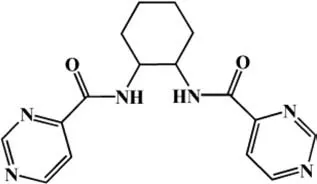
Scheme 1.The 4-bpmah ligand used in this work.
Importantly, the carbon cloth (CC) working electrodes of complexes 1–3 were prepared and used as electrode materials of supercapacitor to study their capacitance performances.In addition,POMOCs 1–3 bulk-modified carbon paste electrodes (1-CPE, 2-CPE and 3-CPE) were used to study their electrocatalytic and electrochemical sensing behaviors for KNO2, KBrO3and Cr(VI).1-, 2-, 3-CPEs as electrochemical sensors can efficiently, sensitively and selectively detect Cr(VI).
The raw materials and instruments, the preparation of electrodes, the calculation of capacitance value and the limit of detection (LOD) are provided in Supporting information.
Synthesis of H2[Cu(4-bpmah)2(SiMo12O40)(H2O)2]·2H2O (1):CuCl2·2H2O (0.038 g, 0.223 mmol), H4SiMo12O40(200 μL,0.014 mmol), 4-bpmah (0.016 g, 0.049 mmol) and H2O (10 mL)were added to a 25 mL autoclave lined with polytetrafluoroethylene and heated to 120 °C for 4 days.Light green crystals were obtained after cooling to room temperature.IR (KBr, cm−1): 3505(w), 3302 (w), 1681 (m), 1664 (m), 1628 (s), 1600 (m), 1551 (s),1464 (m), 1139 (w), 993 (w), 955 (m), 904 (s), 861 (w), 802 (s),678 (w).
Synthesis of H[Cu(4-bpmah)2(PMo12O40)(H2O)2]·2H2O (2): The synthesis of 2 was identical to 1 except that H4SiMo12O40(200 μL,0.014 mmol) was replaced by H3PMo12O40(0.035 g, 0.019 mmol).Green crystals were obtained after cooling to room temperature.IR (KBr, cm−1): 3521 (w), 3295 (m), 1683 (m), 1667 (m), 1630 (s),1601 (m), 1553 (s), 1464 (m), 1140 (w), 1063 (s), 961 (w), 880 (m),808 (s), 681 (w).
Synthesis of [Cu(4-bpmah)(H2O)2]·[Cu2(TeMo6O24)(H2O)10]·4H2O(3): Complex 3 was formed under similar conditions as 1, except that H4SiMo12O40(200 μL, 0.014 mmol) was replaced by(NH4)6[TeMo6O24]·7H2O (0.034 g, 0.026 mmol) and kept at 90 °C for 2 days to obtain blue crystals.IR (KBr, cm−1): 3374 (s), 3065(s), 1628 (s), 1604 (w), 1554 (s), 1473 (m), 1396 (m), 1081 (m),946 (s), 886 (s), 685 (s), 615 (s).
The formation and structure of POMOCs are influenced by many factors such as reaction temperature, reaction materials and pH value of the solution.In this work, complexes 1 and 2 were obtained at 120 °C and pH values around 1.44∼1.69.When the pH value is higher than the original solution (1.69), the products are black precipitate instead of crystalline complexes 1 and 2.Compared with complexes 1 and 2, complex 3 was obtained at a relatively low temperature (90 °C) and a relatively high pH value(3.64).However, at 120 °C, in the pH range of 2.8∼5.64, we could not get complex 3.The results indicated that the temperature and pH value of reaction system have important effect on the formation of title complexes.
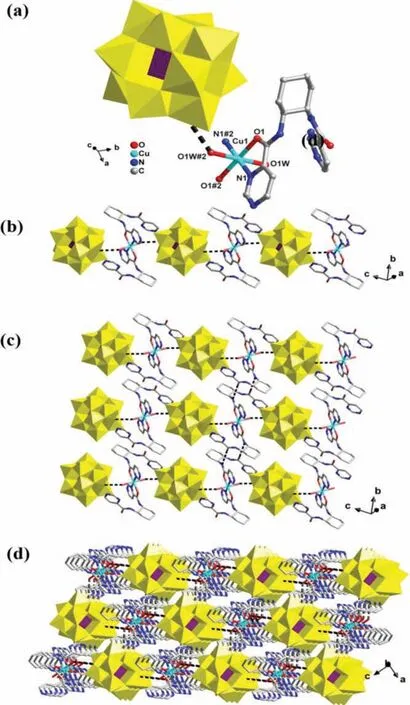
Fig.1.(a) Coordination mode of Cu1 atom in 1; (b–d) View of the supramolecular 1D chain, 2D layer and 3D framework of 1.
In this article, complex 1 and complex 2 were isostructural, so complex 1 was used to describe their structures in detail.A crystallographically asymmetric Cu atom, a [SiMo12O40]4–anion (abbreviated as SiMo12), two 4-bpmah ligands, two coordinated water molecules and two lattice water molecules constituted the asymmetric unit of complex 1 (Fig.1a).The Cu1 atom was coordinated by two 4-bpmah ligands (O1, O1#1, N1, N1#1) and two water molecules (O1W, O1W#1) to form the [Cu(4-bpmah)2(H2O)2]2+metal–organic unit.In 1, SiMo12polyoxoanions were used as counter anions to balance the charges.Moreover, in order to further balance the charges, two hydrogen protons need to be added to the final formula.
In complex 1, [Cu(4-bpmah)2(H2O)2]2n+metal–organic units and SiMo12anions were linked through the extensive hydrogen bond interactions (O1W···O3, N3···O2, O1W···O14) sequentially to form the 1D chain, 2D layer and 3D supramolecular framework(Figs.1b–d).
The fundamental unit of 3 contains three Cu atoms, a 4-bpmah ligand, a [TeMo6O24]6–anion (abbreviated as TeMo6), twelve coordinated water molecules and four free water molecules.The Cu1 atom was coordinated by the nitrogen atoms (N1 and N1#2) and oxygen atoms (O1 and O1#2) of two 4-bpmah ligands, and two coordinated water molecules (O1W and O1W#2).The Cu2 atom was coordinated to a terminal oxygen atom (O2) of a TeMo6anion and five water molecules (Fig.2a).
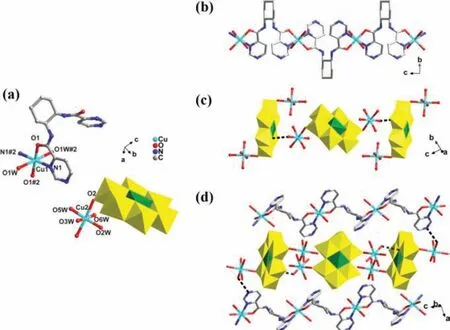
Fig.2.(a) Coordination mode of Cu atoms in 3; (b) 1D metal–organic chain of 3; (c)[Cu2(TeMo6O24)(H2O)10]2n– supramolecular chain in 3; (d) 2D supramolecular layer of 3.
In complex 3, the 4-bpmah ligand connected adjacent Cu1 atoms to form a 1D metal–organic chain (Fig.2b).In addition,two Cu2 atoms connected a TeMo6anion and ten coordination water molecules to form a discrete [Cu2(TeMo6O24)(H2O)10]2–unit, and such [Cu2(TeMo6O24)(H2O)10]2n–units further build 1D supramolecular chains by the hydrogen bond interactions(O5W···O11) (Fig.2c).The above-mentioned two types of 1D chains generated a 2D supramolecular layered structure through the N2···O5W hydrogen bond interactions (Fig.2d).Finally, a 3D supramolecular framework can be formed through the N3···O3 hydrogen bond interactions (Fig.S1 in Supporting information).
Comparing the constructions of title POMOCs 1–3, it can be discovered that the type of POMs show great affect on the structures of the title complexes.
The simulated powder X-ray diffraction (PXRD) peaks of complexes 1–3 match well with those of 1–3 powder samples, indicating that 1–3 have well purity (Figs.S3a-c in Supporting information) [34].As shown in Figs.S3d–f (Supporting information),the characteristic IR peaks at 802, 861, 904, 955 cm–1for complex 1, 808, 880, 961, 1063 cm–1for complex 2 and 615, 685, 886,946 cm–1for complex 3 can be attributed to the SiMo12polyoxoanions [35], PMo12polyoxoanions [36] and TeMo6polyoxoanions [37], respectively.The characteristic bands at 1250∼1690 cm–1can be owing to the 4-bpmah ligand [38].The wider band around 3500 cm–1can be attributed to water molecules.The thermogravimetric curves (Figs.S4a and b in Supporting information) and related descriptions of title POMOCs were described in Supporting information.PXRD and IR analysis proved the successful preparation of 1–3.
In this paper, the effect of electrolyte solution and quality load on the performance of supercapacitors was investigated under a three-electrode system (carbon cloth composite with complexes 1–3 as the working electrode, calomel electrode as the reference electrode and graphite rod as the counter electrode).Among them, 1/CC-1, -2, -5 represent carbon cloth (CC) working electrodes loaded with 1 mg, 2 mg and 5 mg active material (complex 1),respectively.2/CC-2 and 3/CC-2 denote the CC working electrodes loaded with 2 mg of complex 2 and complex 3, respectively.
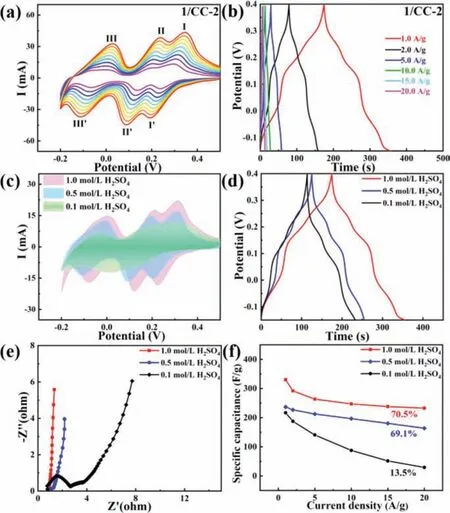
Fig.3.(a) CV curves of 1/CC-2 at different scanning rates (10, 15, 20, 25, 30, 35,40, 45, 50 mV/s); (b) GCD curves of 1/CC-2 at different current densities (1, 2, 5, 10,15, 20 A/g); (c) The CV (20 mV/s), (d) GCD (1.0 A/g) and (e) EIS curves of 1/CC-2 in 0.1 mol/L H2SO4, 0.5 mol/L H2SO4 and 1.0 mol/L H2SO4 solution; (f) Capacitance values of 1/CC-2 at different current densities in 0.1 mol/L H2SO4, 0.5 mol/L H2SO4 and 1.0 mol/L H2SO4 solution.
In order to study the influence of electrolyte solution of 0.1 mol/L H2SO4, 0.5 mol/L H2SO4and 1.0 mol/L H2SO4on the capacitance performance, we firstly studied the cyclic voltammetry(CV) curves and galvanostatic charge/discharge (GCD) performance of 1/CC-2 in the above electrolyte solution (Figs.3a and b, Fig.S5 in Supporting information).Among them, the CV curves at the same scan rate (20 mV/s) of 1/CC-2 in 1.0 mol/L H2SO4has a larger area than that in 0.1 mol/L H2SO4and 0.5 mol/L H2SO4(Fig.3c), and the capacitance values of 1/CC-2 in 0.1 mol/L H2SO4, 0.5 mol/L H2SO4and 1.0 mol/L H2SO4at a current density of 1.0 A/g were 216.9,236.7 and 330.0 F/g (Fig.3d).The electrochemical impedance spectroscopy (EIS) showed that the impedance of 1/CC-2 in 1.0 mol/L H2SO4was less than in 0.5 mol/L H2SO4and significantly less than that in 0.1 mol/L H2SO4(Fig.3e).Among them, the capacitance retention rate of 1/CC-2 in 1.0 mol/L H2SO4was better than that in 0.1 mol/L H2SO4and 0.5 mol/L H2SO4(Fig.3f).The above results all show that 1/CC-2 has better capacitance performance in 1.0 mol/L H2SO4solution.Therefore, the electrolyte solution affects the capacitance performance of the electrode to a certain extent.Among them, 1.0 mol/L H2SO4solution is the best electrolyte solution.
To explore the impact of the quality load on the capacitance performance, we also prepared 1/CC-1 and 1/CC-5 working electrodes, and conducted electrochemical performance tests in the above-mentioned best electrolyte solution (1.0 mol/L H2SO4).Similarly, the CV curves of 1/CC-1 and 1/CC-5 at different scan rates were studied (Figs.S6a and b in Supporting information).At the same scan rate, the integrated area of the CV curve enlarge with the increase of the active material quality load (20 mV/s), which indicates that the active material quality loaded on the electrode influences the integrated area of the CV curve (Fig.4a).

Fig.4.(a) CV curves of 1/CC-1, 1/CC-2 and 1/CC-5 (20 mV/s); (b) GCD curves of 1/CC-1, 1/CC-2 and 1/CC-5 (1.0 A/g); (c) EIS curves of 1/CC-1, 1/CC-2 and 1/CC-5 in 1.0 mol/L H2SO4; (d) Capacitance values of 1/CC-1, 1/CC-2 and 1/CC-5 at different current densities (1, 2, 5, 10, 15, 20 A/g).
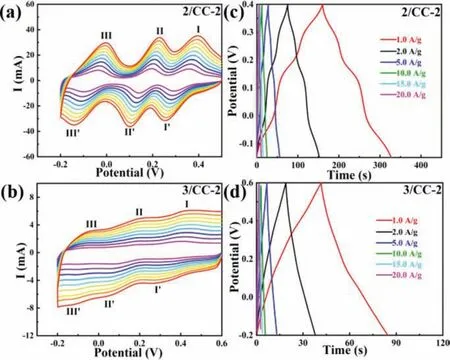
Fig.5.(a, b) CV curves of 2/CC-2 and 3/CC-2 at different scan rates (10, 15, 20, 25,30, 35, 40, 45, 50 mV/s); (c, d) GCD curves of 2/CC-2 and 3/CC-2 at different current densities (1, 2, 5, 10, 15, 20 A/g).
However, the capacitance values of 1/CC-1, 1/CC-2 and 1/CC-5 at current densities of 1.0, 2.0, 5.0, 10.0, 15.0 and 20.0 A/g were 268.6, 238.9, 216.5, 198.4, 193.9 and 189.5 F/g; 330.0, 292.0, 263.7,247.3, 238.1 and 232.7 F/g; 226.0, 200.1, 162.3, 124.6, 90.6 and 58.4 F/g, respectively (Fig.3b, Figs.S6c and d in Supporting information).Among them, under the same current density (1.0 A/g), the specific capacitance of 1/CC-2 (330 F/g) was greater than those of 1/CC-1 (268.6 F/g) and 1/CC-5 (226.0 F/g), as shown in Fig.4b.The EIS curves show that the electrochemical impedance of 1/CC-2 was less than those of 1/CC-1 and 1/CC-5 (Fig.4c).In addition, the capacitance retention rate of 1/CC-2 was also significantly better than that of 1/CC-5 (Fig.4d).Therefore, 2 mg of active material is the optimal quality load in the prepared electrode materials.
Subsequently, the supercapacitor performance of 2/CC-2 and 3/CC-2 were studied under the above-mentioned optimal conditions (Fig.5).The specific capacitances of 2/CC-2 and 3/CC-2 at current densities of 1.0, 2.0, 5.0, 10.0, 15.0 and 20.0 A/g were 303.8,278.9, 253.6, 225.5, 204.5 and 189.1 F/g; 53.9, 47.4, 39.7, 34.8, 32.0 and 29.9 F/g, respectively.At the same current density (1.0 A/g),1/CC-2 has a larger specific capacitance than 2/CC-2 and 3/CC-2,and the capacitance values of 1/CC-2 and 2/CC-2 were significantly better than that of 3/CC-2.The difference in capacitance performance may be attributed to the different polyoxoanions in POMOCs 1–3 [39,40].In particular, Keggin-type POMOCs have a larger specific capacitance than Anderson-type POMOCs.
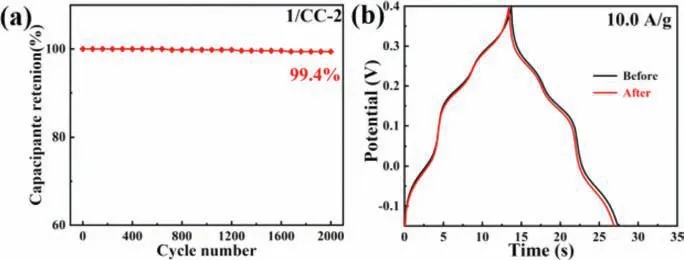
Fig.6.(a) Cycle stability of 1/CC-2 during 2000 cycles (10.0 A/g); (b) GCD curves before and after cycling.
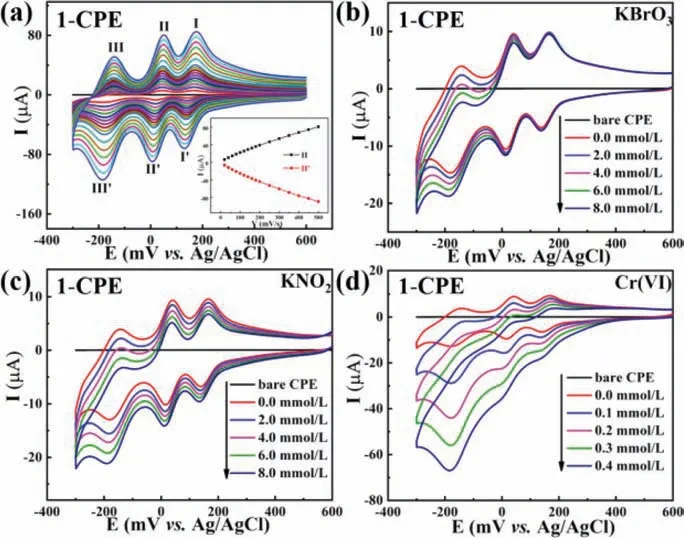
Fig.7.(a) CV curves of 1-CPE at different scan rates (from 20 mV/s to 500 mV/s);CV curves of 1-CPE with different concentrations of (b) KBrO3, (c) KNO2 and (d)Cr(VI).
Furthermore, the cycling stability of 1/CC-2 as electrode material was studied.At current density of 10.0 A/g, 1/CC-2 still has good charge and discharge performance after 2000 cycles with almost no capacitance loss and a capacitance retention of 99.4% (Fig.6).In order to further prove the stability of the title POMOCs in 1.0 mol/L H2SO4solution, we tested the PXRD of POMOCs 1–3 after immersing in 1.0 mol/L H2SO4for 48 h.The results demonstrated that the frameworks of POMOCs 1–3 did not collapse after soaking, indicating that they have favorable stability in 1.0 mol/L H2SO4(Fig.S7 in Supporting information).
In recent years, POMOCs have played a pivotal role in the field of electrocatalysis [41,42].In particular, POMOCs can electrocatalyze the reduction of KBrO3, KNO2and Cr(VI), which are recognized to be toxic and prone to carcinogenesis [43–45].In order to study the electrocatalytic behaviors of the title POMOCs on the above carcinogens, the 1-, 2-, 3-CPEs were prepared and the electrocatalytic performance were studied by CV and ampere currenttime (I-t) methods.
In the CV curves of 1-CPE (Fig.7a), three pairs of redox peaks attributed to polyoxoanions can be observed, where the mean peak potentialsE1/2=(Epa+Epc)/2 were 155, 32 and –159 mV, respectively.In addition, during the scan process, the peak currents were positively correlated with the scan rates, indicating that it is a surface-controlled redox process [46].
In electrolyte aqueous solution (0.1 mol/L H2SO4+0.5 mol/L Na2SO4), when a certain amount of KBrO3, KNO2and Cr(VI) so-lution were added, the reduction peak currents of 1-CPE gradually increased and the corresponding oxidation peak currents gradually decreased, indicating the electrocatalytic reduction ability of 1-CPE for KBrO3, KNO2and Cr(VI), as shown in Figs.7b–d.
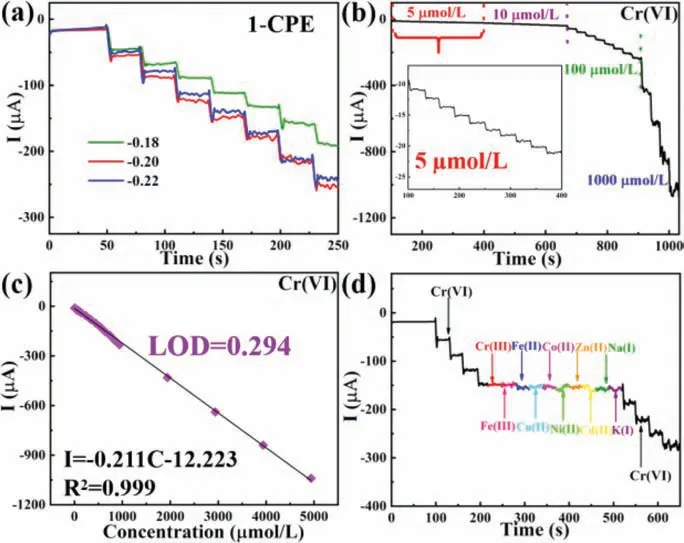
Fig.8.(a) The I-t curves of 1-CPE at different potentials (–0.18 V, –0.20 V and –0.22 V); (b) I-t curve of 1-CPE with different concentrations of Cr(VI); (c) Linear relationship between the concentrations of Cr(VI) and currents of 1-CPE; (d) I-t curve of 1-CPE with continuous addition of Cr(VI) and various ions (CrIII, FeIII, FeII, CuII,CoII, NiII, ZnII, CdII, NaI, KI) to the electrolyte solution.
Cr(VI) has strong carcinogenicity as a class I carcinogen.At present, electrochemical sensors capable of detecting Cr(VI) sensitively, efficiently and selectively have attracted much attention from researchers [47–49].Considering significant electrocatalytic performance of 1-CPE even for low concentrations of Cr(VI), therefore, the current response behavior of 1-CPE to Cr(VI) was investigated using the ampere current method.
Firstly, under different constant voltages, theI-ttest was performed by continuously injecting Cr(VI) solution into the electrolyte to find the best voltage (Fig.8a).Subsequently, the sensing behavior of 1-CPE as a Cr(VI) electrochemical sensor at the optimal voltage (–0.20 V) was studied.Under continuous stirring, K2Cr2O7solution of different concentrations (5, 10, 100 and 1000 μmol/L)were continuously added to the electrolyte solution every 30 s(Fig.8b), and the response current increased with the increase of Cr(VI) concentration.When 1-CPE was used as an electrochemical sensor to detect Cr(VI), the linear regression equation wasIR(μA)= –0.2107 ×C(μmol/L) – 12.2229, the correlation coefficientR2= 0.999 (Fig.8c).By calculation, the LOD of 1-CPE for Cr(VI) was 0.294 μmol/L.In addition, 1-CPE as a Cr(VI) sensor has a linear range of 5∼4940 μmol/L.
Finally, in actual detection, it is of great significance to detect Cr(VI) sensitively and highly selectively, especially the influence of metal ions such as Cr(III) needs to be considered.Under continuous stirring, an obvious current response can be observed after adding Cr(VI) to the electrolyte solution.While a series of metal cations (CrIII, FeIII, FeII, CuII, CoII, NiII, ZnII, CdII, NaI, KI) solution were added to the above solution, there was almost no obvious current response.Afterwards, when Cr(VI) was continuously added,a significant current response can still be observed.Therefore, 1-CPE has high anti-interference ability for Cr(VI) detection (Fig.8d)[12].
In addition, the CV behaviors of 2-CPE and 3-CPE, the electrocatalytic performances of 2-CPE and 3-CPE on KBrO3, KNO2and Cr(VI) have also been studied (Figs.S8 and S10 in Supporting information).Among them, the LODs of 2-CPE and 3-CPE as electrochemical sensors for Cr(VI) were 0.223 μmol/L and 0.755 μmol/L,respectively (Figs.S9 and S11 in Supporting information).The relevant analytical data for 1-, 2- and 3-CPE electrochemical detection of Cr(VI) were listed in Table 1.In order to study the stability of 1-, 2-, 3-CPEs, Cr(VI) solution were added to the electrolyte solution, and the current changed immediately and could be kept stable for 10 h.Subsequently, the PXRD of the electrode materials after sensing was tested, and the results showed that 1-, 2-,3-CPEs have good stability as electrochemical sensors (Figs.S12a–f in Supporting information).Furthermore, the control experiments of 1-CPE and bare-CPE reveal that the increase in current is mainly due to the electrocatalysis of the title complexes (Fig.S13 in Supporting information).The above results demonstrate that the title POMOCs 1–3 can be used as dual-functional electrode materials,not only for electrochemical energy storage, but also for electrochemical sensors to efficiently detect Cr(VI).

Table 1 Analytical data for 1-, 2- and 3-CPEs electrochemical detection of Cr(VI).
In summary, three new POMOCs were obtained by introducing copper ion and a new semi-rigid bis(pyrimidine)-bis(amide) ligand into the Keggin-type or Anderson-type POMs systems, respectively.Complexes 1–3 carbon cloth working electrodes were prepared and their capacitance characteristics were studied.1/CC-2 and 2/CC-2 have superior specific capacitance and capacitance retention rate than 3/CC-2, which is mainly due to the good redox ability of Keggin anions.Among them, 1/CC-2 also has excellent cycle stability after 2000 cycles.In addition, the 1-, 2-, 3-CPEs exhibit good electrocatalytic sensing performance in the detection of Cr(VI), and their LODs are all lower than the standard (1.0 μmol/L) specified by the World Health Organization (WHO).This study not only enriches the structural diversity of POMOCs, but also demonstrates that POMOCs are promising candidates for electrode materials in the field of electrochemical energy storage and electrocatalysis.
Declaration of competing interest
The authors declare that they have no known competing financial interests or personal relationships that could have appeared to influence the work reported in this paper.
Acknowledgments
This work was financially supported by the National Natural Science Foundation of China (Nos.21971024, 21671025) and Liaoning Revitalization Talents Program (No.XLYC1902011).
Supplementary materials
Supplementary material associated with this article can be found, in the online version, at doi:10.1016/j.cclet.2021.12.024.
 Chinese Chemical Letters2022年9期
Chinese Chemical Letters2022年9期
- Chinese Chemical Letters的其它文章
- A review on recent advances in hydrogen peroxide electrochemical sensors for applications in cell detection
- Rational design of nanocarriers for mitochondria-targeted drug delivery
- Emerging landscapes of nanosystems based on pre-metastatic microenvironment for cancer theranostics
- Radiotherapy assisted with biomaterials to trigger antitumor immunity
- Development of environment-insensitive and highly emissive BODIPYs via installation of N,N’-dialkylsubstituted amide at meso position
- Programmed polymersomes with spatio-temporal delivery of antigen and dual-adjuvants for efficient dendritic cells-based cancer immunotherapy
